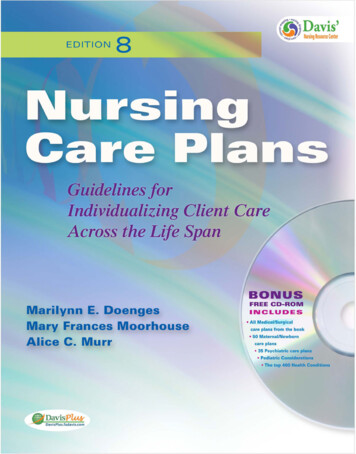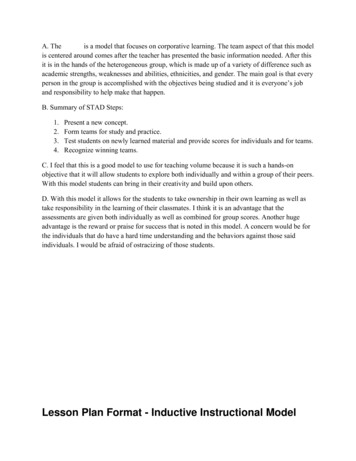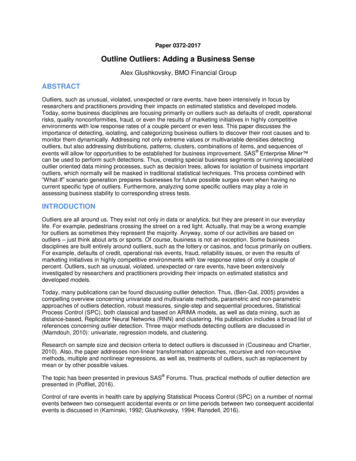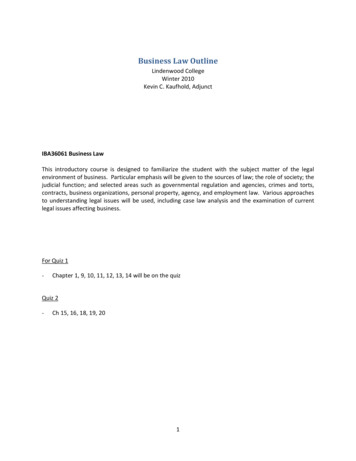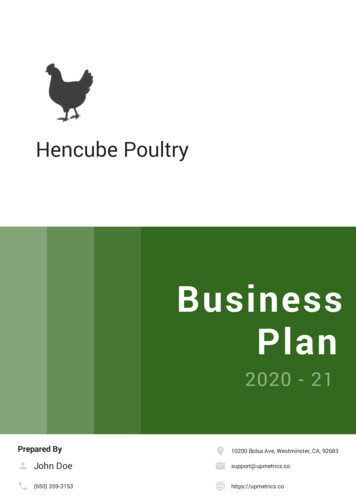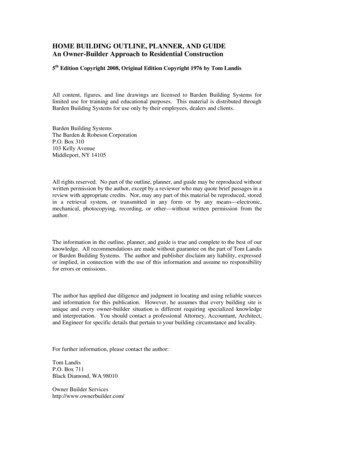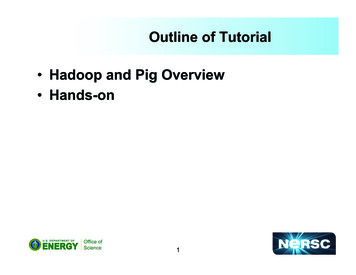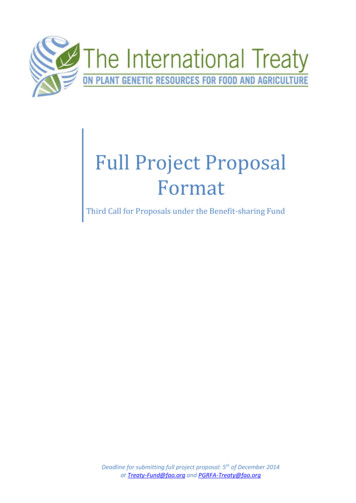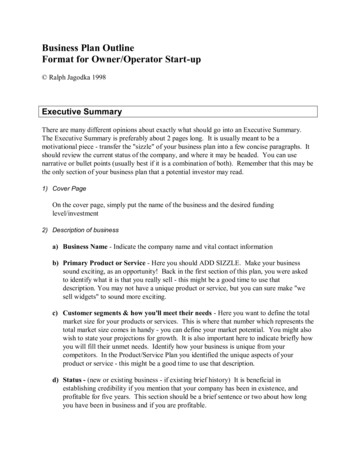
Transcription
Business Plan OutlineFormat for Owner/Operator Start-up Ralph Jagodka 1998Executive SummaryThere are many different opinions about exactly what should go into an Executive Summary.The Executive Summary is preferably about 2 pages long. It is usually meant to be amotivational piece - transfer the "sizzle" of your business plan into a few concise paragraphs. Itshould review the current status of the company, and where it may be headed. You can usenarrative or bullet points (usually best if it is a combination of both). Remember that this may bethe only section of your business plan that a potential investor may read.1) Cover PageOn the cover page, simply put the name of the business and the desired fundinglevel/investment2) Description of businessa) Business Name - Indicate the company name and vital contact informationb) Primary Product or Service - Here you should ADD SIZZLE. Make your businesssound exciting, as an opportunity! Back in the first section of this plan, you were askedto identify what it is that you really sell - this might be a good time to use thatdescription. You may not have a unique product or service, but you can sure make "wesell widgets" to sound more exciting.c) Customer segments & how you'll meet their needs - Here you want to define the totalmarket size for your products or services. This is where that number which represents thetotal market size comes in handy - you can define your market potential. You might alsowish to state your projections for growth. It is also important here to indicate briefly howyou will fill their unmet needs. Identify how your business is unique from yourcompetitors. In the Product/Service Plan you identified the unique aspects of yourproduct or service - this might be a good time to use that description.d) Status - (new or existing business - if existing brief history) It is beneficial inestablishing credibility if you mention that your company has been in existence, andprofitable for five years. This section should be a brief sentence or two about how longyou have been in business and if you are profitable.
e) Legal form - Here you would want to state whether your business is a soleproprietorship, partnership, limited liability company, or corporation.3)Mission and Goalsa) Mission statement - Please limit the length of your mission statement here to a sentenceor two, with, perhaps, a few bullet points.b) Key objectives quantitatively stated - (sales, market share, growth rate) You may wishto indicate annual objectives for sales, market share and growth rate, or you may wish tostate your objectives for only one or two of the items.4) Key financial projectionsa) Investment/ loans required and what used for (matching) - When stating how muchmoney we need, we need to also state how much the owners have infused into thecompany as well. A chart here, perhaps using a stacked bar chart, may clearlycommunicate where investments and monies will go, and how much owners havecontributed. Government loan programs may not want to see their moneys going intoworking capital, but putting those funds to work in securing machinery might appear tobe a more prudent use of the funds.b) Sales projections (figure for the first year) - Here it is important to note that lendersand investors might compare your projections to industry standards, such as thoseobtained from publications such as Robert Morris Associates (R.M.A.) Annual StatementStudies. Your local SBDC will have this publication in their resource library. Thispublication is organized by business type based on a four-digit SIC code, and presentsprofit/loss, balance sheet, and ratio information. Those data are presented relative to thesize of the firm in sales volume, and also relative to the year of operation. These dataprovide a general yardstick for comparison - if our projections indicate a certain salesvolume and certain level of profitability that are contrary to the industry norm, it mightbecome apparent that our numbers are overly optimistic.c) Profit and loss projections (figure for the first year) - Indicate your annual projection,but, as above, compare your figures against the industry standard to establishreasonableness.The Company - Outline1) Name and location2) Company objectives
a) Purpose of the planb) Mission statementc) Advertising slogand) Goalse) ObjectivesGoal:Who responsibleObjective 1:ActivityTime FrameObjective 2:3) Industry Trendsa) Industry background/ trendsb) Nature of your business - what you really sellc) Brief description of product or service4) Company history and Legal Forma) Existing business or new business?b) If an existing business - Companyc) Legal FormMeasurementSign-off
Account Itemizations - Financial PlanThe purpose of this section is to work out the details of how you will categorize and itemize yourfinancial expenses, and to get you to begin the process of obtaining quotes/bids. These exercisesare meant to stimulate thought regarding the extent that expense itemizations exist for yourbusiness opportunity.At this point in time we are not attaching dollar amounts to each of the itemizations - we areinstead looking for the full range of expense itemizations. This will give us a strong feelingregarding the potential cost structure of our business opportunity. Please bear in mind thatmarketing expenses are not included in this section.1) Business InsuranceThere are many types of insurance coverage available to assist your business to mitigate risks.Insurance needs will vary with the types of business you are in because different types ofbusinesses have different types of risks associated with them. The following are the mostcommon types of insurance.a) Auto - Vehicle types usually include automobiles, trucks, or trailersb) Crime – This covers loss due to burglary, theft, computer theft, fraud, or other crimes.c) General Liability - You really must have this type of coverage if you are in businessbecause it covers your customers for potential injury in case of accident. The mostcommon type of coverage includes protection for: customer bodily injury or propertydamage, claims from use of premises, medical payments, off-premises liability, andcontractual liabilities.d) Inland Marine – The covers the movement of goods from one location to another.e) Machinery – Protects with expenses associated with direct damage caused by sudden oraccidental breakdown of a wide variety of electrical or mechanical equipment.f) Medical Malpractice – This covers medical and dental professionals of all kinds.g) Professional Liability – This covers professionals such as accountants, insuranceadjusters and appraisers, architects and engineers, insurance agents, lawyers, real estateagents and non-profit associations.
h) Product Liability – This is a specialized type of coverage which most of the time mustbe purchased separately, and covers against claims arising from the use of a product.i) Property - This type usually includes coverage for signage, newly-acquired buildings,outdoor property, and off-premises property. Additional coverage for spoilage or sewerbackup will allow you to protect against industry-specific risks.j) Umbrella Policy - These types of coverage usually provides for protection for unusualrisks, catastrophes, and additional coverage above and beyond underlying insurancecoverage.2) Contracted ServicesWhat types of independent contractors might you need to utilize? Independent contractorsare not employees - typically they are companies that we use to conduct specialized services.a) Accounting - What types of accounting services might you need to use? The mostcommon types are bookkeeping services, CPA services, payroll services, or tax services.b) Consulting - The most commonly used type of consulting services include managementconsulting and organizational consulting services.c) Legal - Will you need to contract with attorneys? For what purpose? Legal firms can beretained for a set annual fee - allowing up to a certain number of hours service, with a sethourly rate for each additional hour. This may allow your firm to tap into various legalexperts depending upon which need arises.d) Maintenance - These types of contracts will vary depending upon the types of industrialmachinery, office equipment or facilities. These might include anticipated repairservices, copier maintenance, machinery maintenance, vehicle maintenance, securitysystem engineering, or janitorial services. Trash or garbage services are not to beincluded here, as they are considered to be an occupancy expense.e) Marketing - Various types of marketing services maybe contracted. These mightinclude graphic art, advertising agencies, marketing research services, or data analysisservices.f) Personnel - Companies may contract for personnel services. One popular option is tolease back your "own" employees from an employee leasing firm. This process mightallow the firm to drastically lower its burdened employee cost rate - workerscompensation and other mandatory and optional benefits may be purchased at a volumediscount through the leasing firm. Other types of personnel services might includetemporary agencies, secretarial services, or rent-an-executive programs.
3) DebtWhat type of debt do you anticipate obtaining? Please remember that debt, bydefinition, requires that there be a principle amount, an interest rate, and a paybackperiod. If you get a “loan” from mom or dad to “pay back when you can” – that is not aloan (it’s a form of venture capital).Most common sources are:1. Bank loans - home equity2. Bank loans - secured3. Credit union loan4. Family loan
4) Employeesa)Job or Occupational Title - For the purposes of this plan, let us project out forthe first year only. For each type of employee, what is the job or occupational title? Jobor occupational titles can directly relate to the ego of the employee and the image that thejob projects. As an example, is the person a "janitor" or a "maintenance engineer"?Title:How Many F/T?How Many P/T?How Many F/T?How Many P/T?How Many F/T?How Many P/T?How Many F/T?How Many P/T?Brief description:Title:Brief description:Title:Brief description:Title:
Brief description:Title:How Many F/T?How Many P/T?Brief description:b) Number of Full-time or Part-time Help Required - You will need to specify howmany employees will be needed in the first year, and if they will be full-time (F/T) orpart-time (P/T) employees.c) Brief Description - Specify briefly (one or two sentences) what this person will do. Atthis point you do not need to draft out clearly defined job duties, or the skills required forthe job - that will come later when you complete your Personnel Plan. Right now, youwant to get an understanding of how many employees you will need to hire, and whattype of personnel your business will need during the first year.Types of Employees Required - Examples - To assist you, in thinking about the types ofemployees your business may require, a list of examples is included for your review:AccountantBartenderCalligrapherCashierCell boyClerk - InventoryClerk - OfficeClerk - ShippingManagerMechanicOutside sales agent/ lPathologistPhlebotomistPool cleaner
CookCutterDelivery driversDesignerDispatcherElectronic technician/ engineerEngineerFlorist designerGardenerGraphic speopleScreen printerSecretarySecurity guardSign painterSwimming instructorTeachersTinterTravel agentWaiter5) Employer Paid Employee Benefits (Burdened Costs)a) Mandatory Employee Benefits - What are the mandatory types of benefits you will berequired to provide for all employees? These include: social security tax, Federal tax,State tax, and Worker's Compensation insurance. You will need to determine what the"burdened" costs are for each employee in your organization - more on that later, whenwe will provide specific instructions. Part-time employees do require mandatorybenefits. These “burdened costs” may conservatively be estimated as 11.5 % ofemployee salaries.b) Optional Employee Benefits - What are the optional types of benefits that you mightwant to provide to the different types of employees you will have, including yourself?The type of benefits provided may depend upon full-time or part-time employee status,and the philosophy of the owner. The most common types of optional benefits are listedbelow:Types of Optional BenefitsA. Medical insuranceB. Dental insuranceC. Vision insuranceD. Life insuranceE. Pension plan/ Retirement planF. Profit-sharing planG. Employee Stock Option ProgramFull-time employees (other than owners) typically varied in the types of benefits theyreceived from A to A, B, C, D and G. Results were almost unanimous that owners
wished to receive A through G (all benefits). You will need to begin to get quotations forthe types of benefits you want to provide.6) Types of Fixed AssetsFixed assets usually refer to long-term assets, or property that will have a useful life of over oneyear, or have a value of over 5,000. If you plan to expense an item under Section 179 of theInternal Revenue Service Code, you should first check with your accountant to determine howyour assets should be classified. These expenses include common leasehold improvements,which are the expenses related to the construction of new counters, carpeting, tile work, andother improvements of the “bare walls” at your business location. Fixed assets may includeitems such as the following:BoothsCapital equipmentCash registerClothes racksComputersCopy machinesCutting machineD.J EquipmentDelivery van/ vehiclesDisplay casesEquipmentFax machineFixturesFurnitureIndustrial toolsKitchen equipmentLightingMachineryOvensPlantPrinterReal estate propertySandersTablesTelephone systemVideo machinesWashers/ dryers7) Supplies and Miscellaneous Expense ItemsYour business will require many small items, or items that will need to be expensed. Often timeswe don
e) Legal form - Here you would want to state whether your business is a sole proprietorship, partnership, limited liability company, or corporation. 3) Mission and Goals a) Mission statement - Please limit the length of your mission statement here to a sentence or two, with, perhaps, a few bullet points.
